1970-2010 project cycle management evolution
Following 1945 much project cycle management followed the norms of applied by commodity and industrial project design and appraisal. With the emergence of externally funded projects covering a wide range of domains the Log Frame approach was introduced in and case studies, where project design and evaluation was taught often made use of World Bank project records.
However, by 1990s the failure rate of externally funded projects had attained 35% and in the case of agricultural projects the failure rate was higher. In 2010, the Evaluation Group at the World Bank confirmed high failure rates and also reconfirmed that economic rates of return assessments (Cost-Benefit Analyses) were only applied to 20% of funded projects in contravention of internal regulations.
The emerging significance of sociological issues, income disparity, environmental and climatic degradation drew attention to the inadequacy of existing project cycle management approaches. The broader range of disciplines required to design feasible projects required analytical tools which either did not exist or were not widely available or accessible to teams in low income countries.


Why was SDGToolkit developed?
Based on observations of EU-funded projects in Africa over prolonged period as well as in Southern Europe, Hector McNeill and Fahro Belko drew attention to a wide range of shortcomings of existing project cycle guidelines and practice. It was therefore decided to establish the George Boole Foundation to bring together expertise in project design, implementation management, evaluation, systems engineering and information technology to review operational gaps and to establish due diligence procedures for project design.


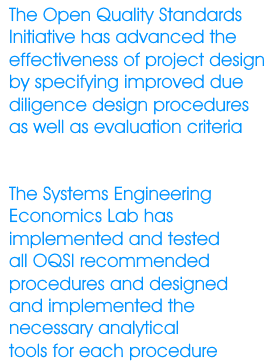
How was SDGToolkit developed?
In 2010 the George Boole Foundation established the Decision Analysis Initiative (DAI) for 5 years to 2015 to make analytical recommendations on how to improve project cycle management methods based on a gaps and needs analysis. In 2015, coinciding with the launch of Agenda 2030 Sustainable Development Goals, the recommendations from DAI were accepted to develop a set of specific due diligence procedures to cover the whole system and to design and implement analytical tools to support the procedural steps. Recommendation were developed by the Open Quality Standards Initiative and these were prototypes in the cloud and tested by SEEL-Systems Engineering Economics Lab. This work laid the foundation of the creation of the SDGToolkit. This second phase of the DAI was completed successfully in 2020.


Decision Analysis Initiative 2010-2020 Final Report
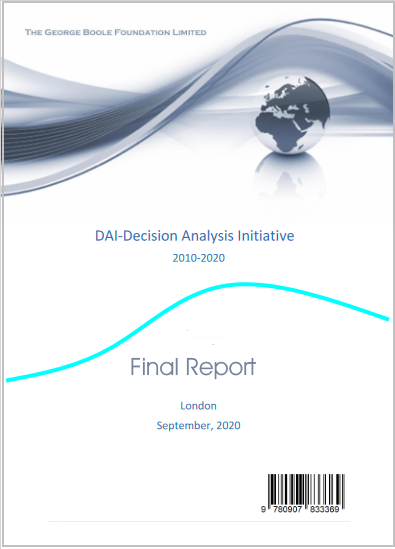
The full report on the Decision Analysis Initiative 2010-2020 concluded that all objectives were achieved with success and in order to continue this innovative development a third phase, DAI 2020-2030 is underway. The Final Report for 2010-2020 can be accesses here


The due diligence & analytical tools concept
According to the domain (agriculture, water economy, conservation) and the stage of the due diligence design procedure the specific analytical tools required to add the "vertical" or domain-specific data, will vary. The increasing library of ATs on board SDGToolkit ensure that an appropriate tool is available to complete the procedure.
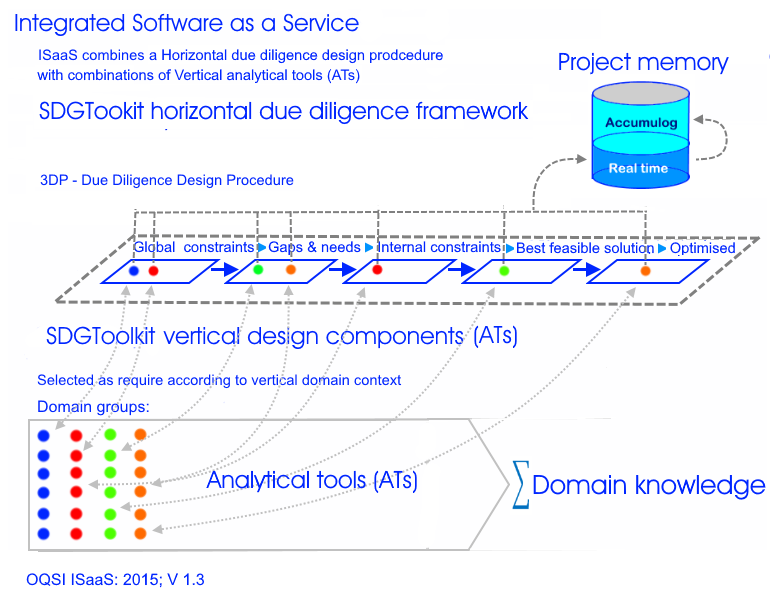

 The components of the due diligence design procedure
The components of the due diligence design procedure  The overall due diligence design procedure consists of four phases. The main emphasis of on design.
The phases are:
- GCA-Global Constraints Analysis
- Assessment of national development constraints facing all projects
- 3DP-Due Diligence design procedures
- Identification of the constraints facing communities and projects according to location
- Designer
- Identification of the final design as a logical project option
- Real Time Monitoring & Evaluation
- Implementation management decision support, on-demand oversight and monitoring and evaluation
|
These are described in the relevance section on this page together with their associated ATs.


Why are ATs so prominent?
Experience over the last 30 years and in particular since the launch of Sustainable Development Goals in 2015, systems teams often lack specific types of expertise and therefore there is a lack of know how on how to carry out specific types of analysis. In any case, for some analyses, analytical tools do not exist. In low income countries there is a general state of lack of access to necessary analytical tools. Therefore, in order to support the demands created by a detailed due diligence multi-step procedures, analytical tools are an essential support, not only to save time but also to specify what information is required as well as to conduct the analysis in a correct and standardized manner.


GCA-Global Constraints Analysis
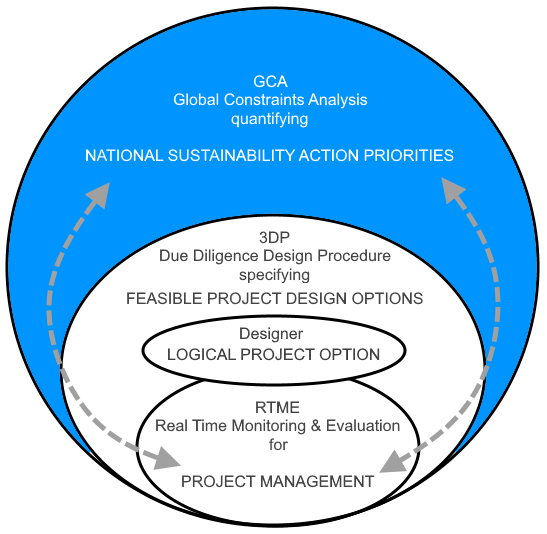 The GCA is designed to re-confirm existing strategic studies that may exist on the constraints on economic development within a country or can be used to establish the nature and extent of national constraints making use of several ATs. These include population projections, determination of trends in purchasing power (real incomes), commodity balance and food balance sheets as well as carrying capacity indicators and the amount of land required to grow import-substituted produce to satisfy requirements for specific foods, for example. A comparative gross margin estimator can compare rain fed, irrigated and covered production system ability to satisfy feasible consumer prices according to purchasing power by income segment.


GCA ATs
The current list of ATs associated with the GCA are as follows. Please note that SDGToolkit is actively developing and adding additional ATs subject to requests and feedback on existing or new ATs. Therefore this list will be incomplete.
- Projections for populations, output requirements and resource consumption
- Population projection
- Comparative national projections for current and desired pc consumption levels
- National consumption transition profiles from current to desired pc consumption levels
- Estimates of national production areas required to meet consumption needs
- Including estimates based on the following production systems:
- Rain fed
- Wetlands
- Irrigated
- Protected
- Covered closed circuit systems
- Shifting clearance and cultivation
- Analysis of availability of commodity complexes
- Current national commodity balance sheets
- Economics of unit prices, purchasing power, real incomes and producer margins
- Sensitivity of real income to population dynamics and inflation
- Disposable real incomes and unit prices
- Target gross margins under followimg production systems
- Rain fed
- Wetlands
- Irrigated
- Protected
- Covered closed circuit systems
- Shifting clearance and cultivation
- Critical production constraints and input factor costs
- Dimensioning of orders of magnitude of target objectives
- Production areas required across different production system options
- Sustainability projection tools: carrying capacity
- Climatic impact projection tools: GHG emissions
- Climatic Benefit Analysis - determination of th climatic impact
- CIP - Climatic impact performance
- Gross budgetary requirements:
- Financial appraisals of identified solutions
- Policy framework and instruments
- Policy portfolio management, monitoring and evaluation


3DP-Due Diligence Design Procedure
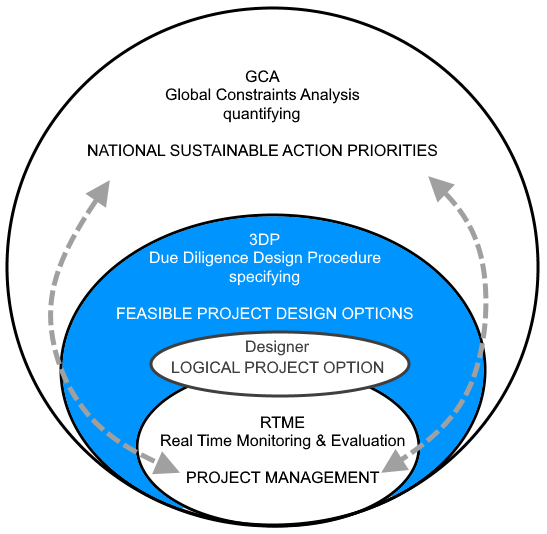 The 3DP consists of a sequence of questions set out is a stepwise format covering the majority of constraints that influence the design of a project. This somewhat detailed coverage of factors is designed to ensure that all relevant factors are taken into account and provided with due consideration.
A "negative logic" or a "strategic precautionary analysis" is applied where no matter what the factor being considered is, all of the possible ways these can inhibit project operations are explored. As a result the strengths and opportunities factors that might be identified under SWOT analysis come under a significant appraisal. This is to avoid presumptions leading to a failure to identify issues with current states-of-the-art which can sometimes be the problem causing gaps.


3DP ATs
- Pre-registration of a project under which to group 3DP entries
- Population, cultural education and health status
- Population
- Culture
- Education & training
- Food security
- Diet
- Drinking water
- Sanitation
- Health status
- Principal pathogens
- Economy, livelihoods, markets and logistics
- Economy
- Livelihoods
- Income distribution
- Inflation
- Associated locational-state properties
- Factor markets
- Produce markets
- Logistics
- International trade
- Environment, ecosystems, carrying capacity & sustainability
- Environmental issues
- Rain and temperature regimes
- Bioclimatic factors
- Genotypes & production systems
- Principal crop pathogens
- Principal livestock pathogens
- Renewable natural resource-based activities
- Technology & techniques
- Water availability/accessibility
- Soils
- Energy
- Pesticides
- Chemicals
- GHG emissions
- Ecosystem issues
- Carrying capacity
- Resilience
- Sustainability
- Other locational factors
- Recorded selection criteria

- Eligibility
- Action objectives
- Constituent membership of team
- Financial criteria
- Other selection criteria
- Constitutional & administrative constraints
- Legal & regulatory
- Levies and taxation
- Financial transfers
- Procurement
- Accounting issues
- Technical and financial audit
- Cross-relationships
- Additional information
- Relevant projects & initiatives
- Any other matters
- Utilities
- Global constraints analyses reports
- General financial calculations
- Critical Economic Rates of Return
- OBA-1: Cost financial return analysis
- OBA-2: Cost feasible income analysis
- Critical Rates of Return to Environment

- OBA-3: Cost carbon footprint reduction analysis
- OBA-3: Cost carrying capacity status analysis
- Locational-state genotypic sequencing
- LSGS-1: Locational-State Genotypic Sequencing - perennials
- LSGS-2: Locational-State Genotypic Sequencing - annuals
- State-of-the-art in ATs
- SOA status of ATs in development
- References
- Boolean Reference Library
- Critical Sustainable Development Goals
- SDGToolkit Manual
- Agenda 2020 Sustainable Development Goal indicators
- OQSI evaluation criteria
- Decision Analysis Brief (DAB) template


Designer-Logical Project Option
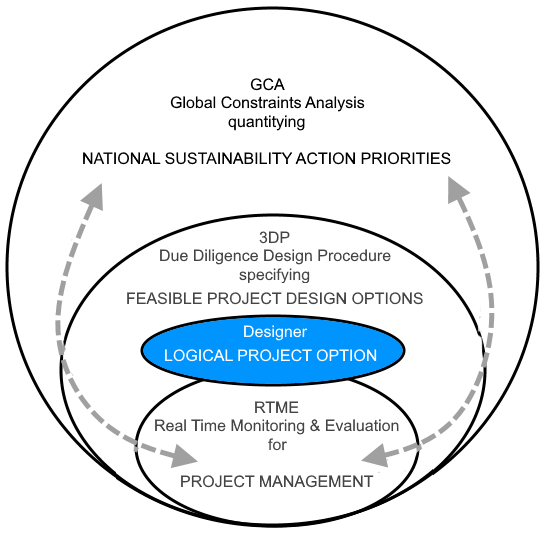 The Designer is a module that provides the interfaces and forms to input the project task layout and input details. In this case there are no analytical tools but rather input modules that make use of the results of the GCA and 3DP to identify the most appropriate project design. What is input is considered to the most Logical Project Option (LPO)
The LPO is considered to represent the optimized plan for a project and it establishes the performance benchmarks or expectations of timing, input quantities, values, outputs and output quantities divided into up to 5 phases and 5 tasks within phases.
The performance benchmarks are used as the desired attainment levels to be assessed by the monitoring and evaluation system in the RTME system.


Design ATs
Designer makes use of the comparative data generated in the GCA and 3DP procedures to input data values covering:
- Number, names and sequence of project cycle phases
- Number and names of tasks per phase
- Duration of each phases
- Duration of each task
- Processes deployed in each task
- Specifications of variable inputs and their costs per task
- Human resource specifications and inputs and costs per task
- Output specifications, including byproducts and waste, quantities and value per task


RTME-Real Time Monitoring & Evaluation
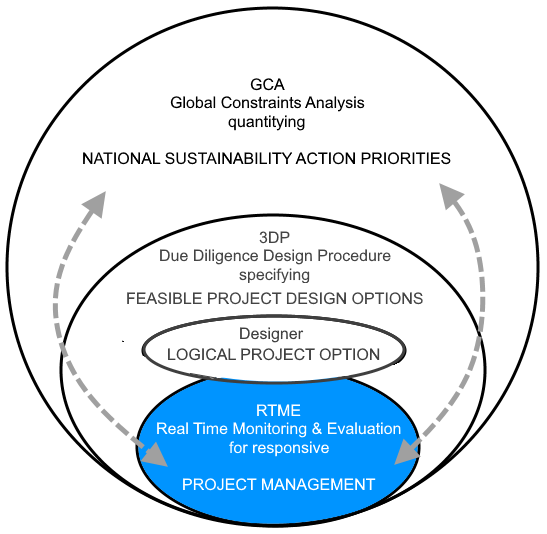 The RTME provides a general access to the results of all of the other phase outputs including a Logical Project Options (a type of Log Frame but providing access to more detailed information) as well as phase and project Gantt charts.


RTME ATs
Because of its access to the records of all phases including ongoing implementation decisions and their outcomes the RTME has a real time oversight capability. Naturally the relative utility of this capability depends upon a regular update of project implementation events. This is maintained through an internal evaluation system which operates on the basis of providing a recording system of the performance of any task at the time of scheduled termination. Therefore at any particular time portfolio managers can obtain updated project progress status reports.


OBA-Options Benefit Analyses
Options Benefit Analysis (OBA) is a series of ATs to provide specific quantified estimates of the impact of project configurations. These are similar to financial cost-benefit analysis but the benefits measured are different in each case. For example:
- financial return
- real income generation
- carbon footprint reduction
- carrying capacity impact
The OBA series is being extended according to stakeholder and customer requests and advancing knowledge of requirements.


OBA-Options Benefit Analyses - Economic Rates of Return: finance and real income
OBA-1 provides the standard cost-benefit analysis (CBA) to calculate the economic rate of return of a project configuration.
Note: The nature of climate change relating to temperature rises is complicates by seasons variations in maximum and minimum temperatures by something like =/- 5oC in any given year and on the maxima this can exceed the 1.5oC climatic target causing considerable damage through physiological temperature related impacts as well as impacts of water deficit. This causes CBA estimates to be unreliable. Therefore this AT is subject to a change in methodology and project production system design linked to Locational-State Genotypic Sequencing (see below).
OBA-2 provides a cost benefit analysis where benefit is measured as aggregate real incomes generation.


OBA-Options Benefit Analyses - Rates of Return to the Environment: carbon footprints & carrying capacity
OBA-3 provides a cost-benefit analysis where benefit is measured as carbon footprint reduction.
OBA-4 provides a cost-benefit analysis where benefit is measured as resulting changes in carrying capacity of the natural resources used by a project.


Performance and Sustainability Critical Path
This OQWSI critical path is used to reiterate design options in terms of input/out put specifications for processes (tasks) to identify optimal positions for financial sustainability and carrying capacity balancing ERR and RRE.
Resulting logical project options (LPO) should at least be neutral in terms of carrying-capacity and preferably positive. 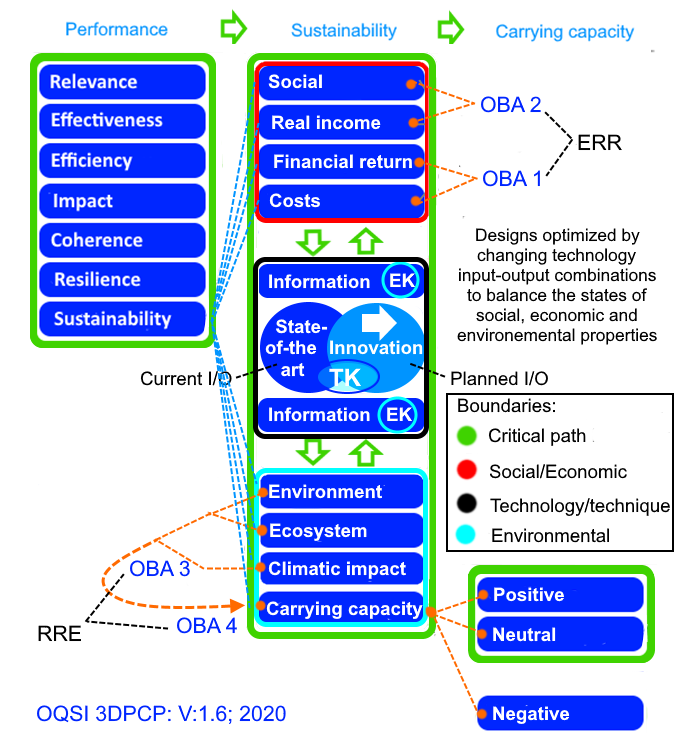 

LSGS-Locational-State Genotypic Sequencing - perennials
This AT provides a procedure to rank available perennial genotypes into a sequence indicating if and when a particular production area should be replaced and by which alternative genotypes.
This makes use of historic averages to determine the highest likelihood variance cycles to be expected relating to maximum and minimum temperatures and water deficits. These limits set thresholds on genotypic sensitivities.


LSGS-Locational-State Genotypic Sequencing - annuals
This AT provides a procedure to rank available annual genotypes into a sequence indicating if and when a particular production area should be replaced and by which alternative genotypes.
This makes use of historic averages to determine the highest likelihood variance cycles to be expected relating to maximum and minimum temperatures and water deficits. These limits set thresholds on genotypic sensitivities.


Frequently asked questions
This section is frequently updated but questions tend to be fairly limited and concentrated on the questions listed below. All questions asked are answered.
If you have a question not covered in this list please send your question to: support@sdgtoolkit.com
Many people in low income countries do not have access to the Internet so how can this system be used?
| SDGToolkit is meant for local agronomists and extension personnel and the majority possess laptops and have access to the Internet. The system works best with a limited number of practitioners using the system for data input but this work being based on work involving stakeholder participation, often field based. In most countries access to the Internet is increasing.
|
Do you provide technical support?
| We provide technical support on:
- Server operations
- Bug removal in programs and tools
- Adjustment of tools to accommodate unusual input requirements
- Ad hoc guidance on use of tools - see training
|
Can you change or develop new tools on request?
| Yes. This involves us in gaining oversight of the reasons for requests because sometimes solutions can be counter-intuitive and a full understanding of the issue being analyzed is required. Once we fully understand the client's objectives we can specify the required mathematical logic and implement the tool.
|
How do you handle client data on a shared VPN or dedicated server?
| Each client's provisions are based on a dedicated server that is not shared with any other clients. As a result there can be no mixing of data from different clients. A dedicated server also allows us to introduce specific procedures and configurations which clients require and implemented as our client specific management of the system.
|
How do clients access the system.
| Those authorized by the client can access the system vis a name and PIN entry generated on registration of each person thus authorized. Within the system the normal access rights apply.
|
What are the data security arrangements?
| Overall data security we apply all server operating system updates on the day of release and normal precautions are taken to protect systems from various forms of known abuse.
| Is training ad hoc or do you provide formal courses?
| Yes, courses of study accompany the provision of the service and these courses advance at the rate required by clients. Courses are structured so that:
1. Clients can initiate their operational project designs following the courses
2. Alternatively we can also support clients who want to learn more rapidly on-the job in a tutorial fashion to support client while they are designing projects
|
Do you provide courses for non-clients?
| Yes. These are provided more along the lines of explaining Open Quality Standards Initiative recommendations concerning due diligence design procedures and how each tool supports each procedure. Non client courses are charged for at reasonable rates. |
Does OQSI or SDGToolkit issue certificates for courses?
| OQSI and SDGToolkit.com are not certification or educational institutions. However, The George Boole Foundation Limited as the leading applied research organization to which OQSI, SEEL and SDGToolkit.com are affiliated and can issue course attendance confirmation statements and accomplishment statements in the case of course that contain tests. |
Do these courses carry grades?
| No. On the courses that carry tests to assess professional competence levels, you either pass or fail. However the courses are graded both in terms of content and test complexity. There are no multiple choice questions but rather questions that examinees need to answer in narrative form with questions being strictly linked to course content. |
| Do you have a course curriculum posted online? | The content of the SDGToolkit course will be posted in June 2021.
| How are these courses and the tests conducted?
| They are a mixture of video conferencing and workshops, access to original online resources posted by OQSI, SEEL and sometimes the Foundation concerning evolving technical questions on SDG topics, working with sections of the SDGToolkit online and tutorials on leading-edge topics.
Tests are a mixture of live online orals and written material that is later marked (usually with a very rapid turnaround so that follow up is easier to understand) |
|
|


|

